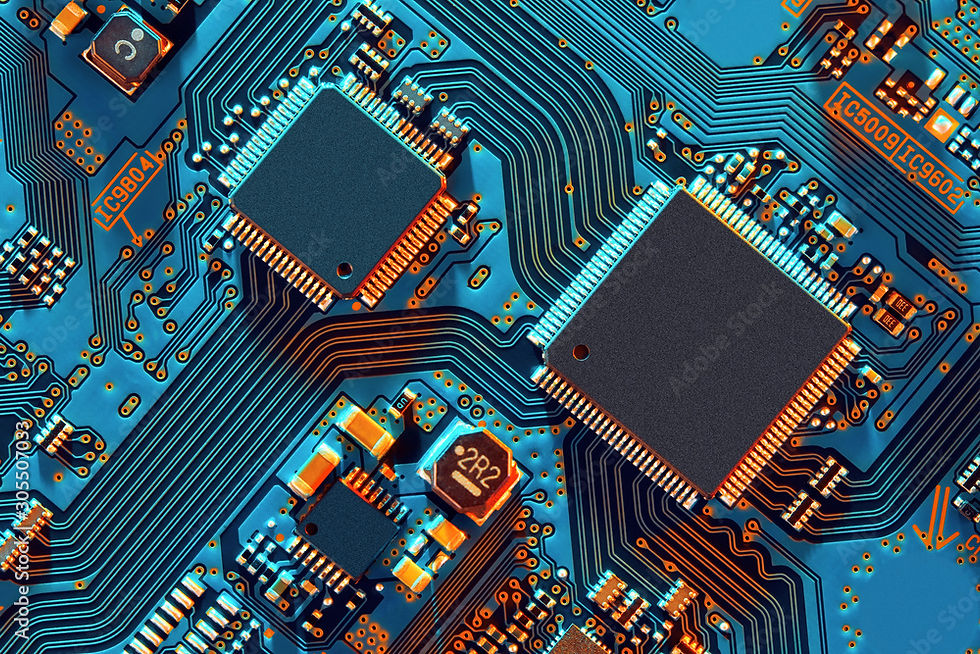The Future of Semiconductors: Navigating a Transformative Landscape
- Daniel Ezekiel
- Mar 24
- 4 min read
Updated: Jun 15

Introduction: Navigating the Shifting Landscape
The semiconductor industry is experiencing a profound transformation, driven by the explosive growth of AI acceleration, RISC-V adoption, neuromorphic computing, and intelligent edge computing.
Traditional players like Broadcom, Qualcomm, Intel, AMD, and NVIDIA face both unprecedented opportunities and significant challenges.
Historically, semiconductor advancements revolved around refinementsand optimisation of the Von Neumann architecture: increased clock speeds, node shrinking, faster bandwidth, complex instruction sets, and optimizations in memory and instruction processing. This led to the proliferation of specialized compute units, including GPUs, sensing hubs, interconnects, Accelerator IPs, and heterogeneous compute architectures integrating DSPs, accelerators, and FPGAs.
The rise of ARM, particularly enabled by Nokia's shift from DSPs, revolutionized the mobile industry. Now, ARM's nascent but significant push into PCs and data centers is reshaping the landscape. As x86 architectures approach their limitations, custom silicon solutions from hyperscalers (AWS Graviton, Google TPU) threaten the dominance of incumbent giants.
While x86's longevity is secured by its robust software ecosystem and established presence in PCs, data centers, and servers, its vendor lock-in (Intel and AMD) and closed ecosystem pose challenges. The AI revolution, fueled by inferencing across via multimodal sensing (vision, LiDAR, radar, ultrasonics) and the explosive growth of LLMs and GenAI, initially prioritized performance. However, with widespread adoption, power efficiency has become paramount. The traditional heterogeneous GPU/CPU/Accelerator model, based on Von Neumann architecture, suffers from memory inefficiencies and consequently, power limitations.
Emerging architectures like Groq's LPUs, Untethered AI's At-Memory-Compute, and Cerebras' 'Wafer Scale Engine' represent a fundamental departure from the Von Neumann paradigm, offering vastly superior power and performance metrics. The increasing adoption of chiplet designs will empower startups to develop specialized solutions for AI, Sensing, and other niche applications, either as IP integrated with x86 or ARM-based chipsets. The era of monolithic chipsets is gradually ending, with disaggregation becoming the key.
Which companies are adapting effectively? Who faces the greatest risks? And what does this mean for the future of computing? ...
1. Broadcom: The Aggregator Strategy – Sustainable or Innovative?
Strengths: Dominance in networking chips, ASICs, and custom silicon. Strategic acquisition of VMware, strengthening its enterprise software portfolio. Robust cash flow and high-margin licensing model.
Challenges: Heavy reliance on enterprise consolidation rather than organic innovation. Potential decline in demand for legacy monolithic architectures due to AI and edge computing growth. Regulatory scrutiny of acquisitions, potentially hindering future expansion.
Strategic Outlook: Broadcom's challenge lies in transitioning from an acquisition-driven model to a culture of innovation, and working towards win-win solutions with its customers.
2. Qualcomm: Navigating Beyond the Mobile Realm
Strengths: Leading AI inference capabilities on mobile devices. Expansion into automotive and industrial IoT (Snapdragon Ride, Digital Cockpit). Strong patent portfolio and licensing business. Fast transformation capabilities, and segue into additional verticals.
Challenges: Potential impact on profitability due to ARM's increasing licensing fees. Threat to a key revenue stream from Apple's shift to in-house modems. Continued over-reliance on the mobile market despite diversification efforts.
Strategic Outlook: Qualcomm must accelerate its AI and edge computing initiatives beyond smartphones to maintain competitiveness.
3. Intel: Reclaiming Leadership in Foundry and AI
Strengths: Intel Foundry Services (IFS) initiative to compete with TSMC and Samsung. Significant R&D investments in AI accelerators and next-generation computing (Gaudi , Falcon Shores). Financial stability through US government backing (CHIPS Act). Early adoption of Networking and OpenRAN.
Challenges: Lagging behind TSMC and Samsung in advanced process nodes (3nm, 2nm). Erosion of x86 dominance by ARM and RISC-V. Bypassing of Intel by cloud providers developing custom silicon (AWS Graviton, Google TPUs). Repeated delays in roadmap execution, and slow adoption of OneAPI.
Strategic Outlook: Intel's success hinges on its ability to become a leading foundry, maintain its AI relevance, and preserve its data center and PC market share.
4. AMD: Maintaining Momentum in a Dynamic Market
Strengths: EPYC chips' strong presence in the data center, challenging Intel. Growing AI capabilities with Instinct MI300 accelerators. Strategic acquisition of Xilinx, bolstering its position in FPGAs and adaptive computing.
Challenges: Uncertainty in achieving AI dominance against NVIDIA's established lead. Continued x86 dependency in an ARM/RISC-V-driven landscape. Potential limitations to aggressive growth due to supply chain constraints.
Strategic Outlook: AMD's agility is its advantage, but its ability to execute AI strategies and diversify beyond x86 will determine its future.
5. NVIDIA: Navigating Power and Cost Challenges
Strengths: Dominance in AI training and inference. Well-established CUDA software ecosystem. Continued growth in gaming, data center, and automotive sectors. Entry into Telecom with AI-RAN CPU/GPU integration.
Challenges: High cost and power consumption of GPUs. Emerging competition in AI training (Cerebras WSE). Emerging competition in AI inferencing (Groq LPU).
Strategic Outlook: NVIDIA's ability to address power consumption and cost efficiency in AI inference will be crucial for its continued success.
6. The Rise of RISC-V and Custom Silicon: A Paradigm Shift
Why It Matters: RISC-V's increasing adoption in embedded systems and AI accelerators. Hyperscalers' development of custom silicon, bypassing traditional chipmakers. China's heavy investments in RISC-V to reduce reliance on US firms.
Who’s at Risk?
- Intel and AMD: Vulnerable due to their x86 dependency.
- Broadcom: Potential disconnect between enterprise software focus and custom silicon trends. RISC-V alternative to ARM based solutions
- Qualcomm: RISC-V as a potential alternative to rising ARM licensing costs.
- Nvidia: High GPU cost and power consumption.
Final Thoughts: Identifying the Winners and Losers
Winners: Companies that diversify into AI, edge computing, and custom silicon, while fostering strong ecosystem partnerships.
At Risk: Companies overly reliant on legacy architectures, mobile licensing models, or acquisition-driven growth.
Where do you see the semiconductor industry heading? How does this impact your business? How can you position yourself for success?
Let's connect for a deeper discussion.



